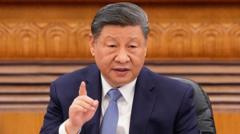As US President Donald Trump ramps up tariffs against a wide range of nations, his actions are being characterized as a direct challenge not only to China but also to several Southeast Asian countries. In a recent address, Trump criticized China for what he described as economic exploitation of the US, openly declaring that tariffs on Chinese goods would climb from an existing rate of 20% to an eye-popping 54% soon.
The immediate response from China was one of indignation, with officials labeling the tariffs "a typical act of unilateral bullying." The Chinese Commerce Ministry announced plans to adopt "resolute countermeasures" in order to protect national interests.
Trump's latest measures do more than just apply pressure to Beijing; they also extend to other Southeast Asian nations, namely Vietnam, Laos, and Cambodia, where tariffs could rise dramatically, thereby disrupting the supply chains that have become increasingly reliant on Chinese factories and labor. This is described as a strategic maneuver to thwart China's capacity to shift production in response to previous tariffs.
Economic experts underscore the significant ramifications for Southeast Asian nations, which have historically benefited from trade with China. Deborah Elms, an analyst from the Hinrich Foundation, indicated that the compounded tariffs are particularly harsh for these countries, suggesting that they, along with China, will need to respond decisively to mitigate economic fallout.
Recent tariffs imposed on Vietnamese goods have been speculated to target the country directly due to its role in facilitating trade for Chinese manufacturers seeking alternatives to US tariffs. The shifting of manufacturing bases following previous trade tensions had initially positioned Vietnam favorably, increasing its exports to the US, but the new tariff structure threatens to destabilize that balance.
As American businesses with significant investments in Southeast Asia, including major technology and retail firms, brace for potential layoffs and operational disruptions, the impending tariffs nurture a climate of uncertainty. This could lead to a chain reaction that may compel China to pursue alternative markets and build stronger alliances within the region, possibly prompting collaborations with South Korea and Japan.
In the larger scheme, the recent developments signal a potential reconfiguration of global trade dynamics, as countries affected by Trump's economic policies grapple with their responses. Experts predict that negotiations between the US and China may be necessary in the near future, but immediate tensions may continue as both sides evaluate their strategic moves in this complex economic landscape.




















